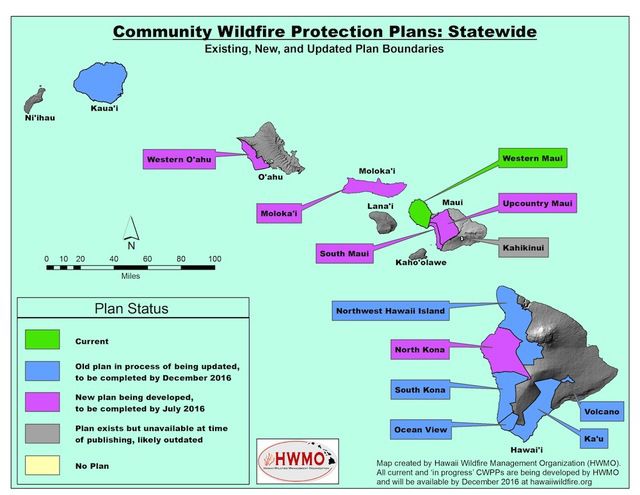Recent rains may have bumped Kauai from a state of drought, but the boost of extra water is also throwing up red flags for fire experts. “Don’t be fooled by the rain we might get and think we’re off the
Recent rains may have bumped Kauai from a state of drought, but the boost of extra water is also throwing up red flags for fire experts.
“Don’t be fooled by the rain we might get and think we’re off the hook,” said Elizabeth Pickett, executive director of Hawaii Wildfire Management Organization, a nonprofit that’s dedicated to spreading wildfire education. “Rain makes more vegetation grow, that dries out and then there’s more fuel for wildfire.”
Pablo Beimler, HWMO coordinator, said with the extensive drought period the state experienced earlier this year, and the EL Nino phenomenon that’s in effect “could spell trouble in the number of ignitions and the sizes.”
“That’s in line with the El Ninos we’ve had in the past,” Biemler said. “In previous El Ninos, May and June were the wetter months and they were followed by a typical dry summer.”
In preparation for that dry summer, HWMO has been working on six Community Wildfire Protection Plans, which outline the wildfire hazard sand issues each specific community faces, the organizations and entitles that have a stake in wildfire management, and how they can work together to minimize the number and sizes of wildfires this season.
Kauai’s plan, which was originally created in 2009, is in the process of being updated, and the organization is developing plans for western Oahu, Molokai, south Maui, upcountry Maui and north Kona.
The goal is to have all areas that are deemed high risk for wildfires to have CWPPs completed by July.
“The plan is comprised of input from anyone who was concerned enough to come to the meetings, and anyone who has a stake in management,” Pickett said.
She said the CWPP format is a nationally used to ensure that everyone who is concerned about wildfires has a place to share their thoughts and to offer ideas for taking action.
“The real meat of the plan is to move forward and figure out where our priorities lie,” Pickett said.
She said the meetings offer an opportunity to bring everyone onto the same page and discover ways to work together to prevent wildfires.
For Kauai, the area with the most wildfire concerns is the Westside, and the biggest issue is vegetation management. Access to the areas to the wilderness areas where wildfires occur and access to water were also concerns that were heavily voiced on Kauai.
“Some of those areas only have one or two access roads and the fire trucks may not be able to turn around if they need to,” Biemler said.
Pickett said as the state moves into the dry season, the number one goal is to prevent anything from burning. When fires start, the goal is to have the resources in place to keep them small.
Over the past decade, Hawaii’s wildfire season has been trending toward more fires, larger acreage being burned, and more damage occurring from the fires, according to a study conducted by HWMO and UH-Manoa.
“Everything is getting worse and worse,” Pickett said. “Part of the issue of why we have such a fire issue is that over 25 percent of our state is now covered in invasive, fire prone species.”
She explained as wildfires wipe out the native forest species, invasive species that thrive in fire-blackened conditions take over the empty space and the forest is diminishing.
“We’re gaining a fire prone landscape and the tendency to burn is increasing over time,” she said.




